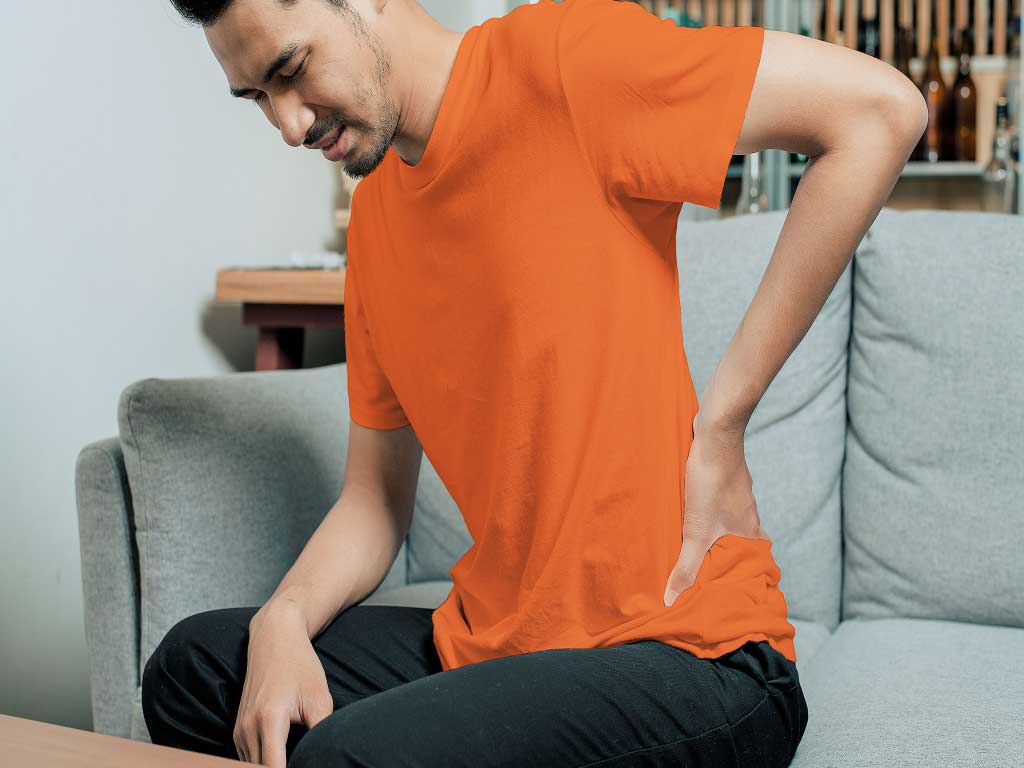
Sciatica is a debilitating condition characterised by pain radiating from the lower back down to the buttocks, legs, and feet. The pain manifests in numbing, sharp, or shooting sensations similar to pins and needles penetrating the skin. Thus, people try various ways of treating sciatica. The conservative treatments include physical therapy, medications, electrical stimulation, and hot and cold methods. In severe cases, a doctor may advise more drastic measures, such as spinal injections or surgery.
There are many causes and risk factors of sciatica pain. Primarily, it occurs when the sciatic nerve, the longest nerve in the body, is compressed or irritated. Various health conditions can lead to nerve entrapment, including herniated discs, arthritis, and diabetes. Moreover, it is also common as people age. Fortunately, exploring several treatment options allows individuals to find the most effective remedy. This article will explore the various methods of sciatica treatment to help improve the quality of life.
Jump to a Section:
- Transcutaneous Electrical Nerve Stimulation (TENS) for Treating Sciatica
- Hot and Cold Packs for Treating Sciatica
- Medications for Treating Sciatica
- Stretching Exercises for Treating Sciatica
- Physical Therapy for Treating Sciatica
- Acupuncture for Treating Sciatica
- Chiropractic Therapy for Treating Sciatica
- Massage Therapy for Treating Sciatica
- Spinal Injections for Treating Sciatica
- Surgery for Treating Sciatica
Transcutaneous Electrical Nerve Stimulation (TENS) for Treating Sciatica
Transcutaneous Electrical Nerve Stimulation (TENS) is a popular contemporary form of pain relief for treating sciatica and other chronic pain conditions. TENS work by sending small electrical impulses through electrodes placed on the skin near the pain area. The impulses help to disrupt the pain signals from reaching the brain. It also triggers the release of endorphins, the natural painkillers.
The TENS machine is a portable device consisting of a pulse generator and adhesive electrodes. It has adjustable controls to modify the pulse rates, duration, and intensity of the electrical currents. This customisation feature enables individuals to tailor their pain treatment according to their comfort level and pain intensity.
To operate the TENS machine, simply place the electrodes on the pain area, typically on the lower back. Position the pads on each side of the spinal cord or along the affected nerves. Next, start with a low intensity and gradually increase until the tingling sensations are strong but comfortable. It is essential to consult a healthcare provider first before starting TENS therapy to ensure it is the right course of treatment.
Advantages of TENS Therapy
- TENS therapy is a drug-free, nonsurgical method of relieving pain.
- The natural approach minimises the risk of adverse side effects usually associated with medicines. It also does not have the potential to develop dependency or addiction problems.
- It is a safer and more comfortable option for those who cannot tolerate medications or are not suitable candidates for surgery.
- The TENS machine can be used at home, providing individuals with immediate pain relief whenever needed.
- TENS can be administered without the supervision of a healthcare professional.
- It is a cost-effective treatment option, minimising the need for regular therapy sessions.
Hot and Cold Packs for Treating Sciatica
Hot and cold packs are a common and effective remedy for treating sciatica pain. Heat treatment helps to relax the muscles, increase blood flow, and reduce stiffness. The improved circulation can aid in speeding up the healing process of any injured tissues, muscles or nerves. Additionally, heat helps reduce muscle tension and improve flexibility.
On the other hand, cold therapy can help reduce inflammation, numb the area, and alleviate pain. Cold packs constrict the blood vessels, which maintain the normal internal temperature. The nervous system also works to stop the core body temperature from dropping and to keep vital organs working.
Using cold and hot packs for sciatica can provide temporary relief from symptoms like dull aches. One advantage of this treatment is they are easy to do at home. They can also be used in combination with other methods to provide a more comprehensive approach to managing the pain of sciatica. However, it is important to remember that they can provide temporary relief but not address the root cause of the condition.
Applying Hot and Cold Packs
Applying hot and cold packs for pain relief is easy. Use cold therapy at the onset of sciatica to reduce swelling and pain. Place a cold compress on the affected area for 15 to 20 minutes. Remember to wrap the pack in a towel to avoid direct contact with the skin.
For heat therapy, use a heating pad, warm towel, or hot water bottle to the affected area. Leave the heat pack on for 15 to 20 minutes as well. It is essential to alternate between hot and cold packs every two to three hours for optimal pain relief.

Medications for Treating Sciatica
Pain medications for treating sciatica are affordable and readily available in pharmacies and drugstores. This makes it an accessible and cost-effective pain relief option. There are two main types of analgesics, namely, nonsteroidal anti-inflammatory drugs (NSAIDs) and acetaminophen. NSAIDs work by inhibiting the production of prostaglandins, hormone-like substances playing a key role in inflammatory response.
Acetaminophen, on the other hand, is a mild pain reliever and fever reducer. It works by blocking pain signals in the brain. However, it does not have anti-inflammatory properties. People who cannot tolerate or have adverse reactions to NSAIDs may take acetaminophen or paracetamols as an alternative. It is also typically milder and has fewer side effects compared to NSAIDs.
For more severe cases of sciatica, doctors may prescribe opioids or muscle relaxants. Opioids are powerful painkillers but can have serious side effects and risks of dependency. Muscle relaxants may help alleviate muscle spasms and stiffness, but they can cause drowsiness and dizziness. It is vital to follow the dosage instructions of the physician to prevent any complications.
Over-the-Counter Medicines for Relieving Sciatic Pain
Over-the-counter (OTC) medicines are a convenient and accessible option for relieving sciatic pain. NSAIDs and paracetamols are available without needing a prescription. When taking OTC medications, it is crucial to follow the recommended dosage and not exceed the maximum daily limit to prevent potential side effects.
Some common OTC NSAIDs are ibuprofen, naproxen sodium, and aspirin. Paracetamols like Tylenol can provide short-term relief for sciatic nerve pain. Additionally, it is essential to read and understand the warnings and precautions on the medication packaging. Overall, pain medications are ideal for temporary pain relief but may not be safe for long-term use.

Stretching Exercises for Treating Sciatica
Stretching exercises can be an essential component of a comprehensive plan for treating sciatica. It is another nonsurgical treatment method that can be done in a pain clinic or at home. They can help improve flexibility, reduce stiff muscles, and alleviate pressure on the sciatic nerve. Regular stretching can also improve posture and reduce the risk of future flare-ups of sciatica.
Another advantage of stretching exercises is they can help increase the range of motion and mobility. When the muscles surrounding the sciatic nerve are tight and tense, it can restrict movement and lead to stiffness and discomfort. Incorporating low-impact aerobic exercises into daily routine can enhance overall nerve and muscle functions.
In addition to physical benefits, stretches can also have a positive impact on mental health. Regular, gentle exercise can help reduce stress and tension in the body, which can alleviate pressure on the sciatic nerve. It is also an effective way to release endorphins. In summary, they promote pain relief, relaxation, mindfulness, and improved circulation.
Best Stretches for Relieving Sciatic Pain
- Piriformis Stretch: The piriformis muscle runs through the buttocks and can sometimes irritate the sciatic nerve. Lie on your back with both knees bent. Cross one ankle over the opposite knee and gently pull the bottom leg towards your chest.
- Hamstring Stretch: Sit on the floor with one leg extended and the other bent. Lean forward from your hips towards the extended leg, keeping your back straight.
- Lower Back Stretch: Lie on your back with both knees bent. Slowly bring one knee towards your chest and hold it with both hands. Hold the stretch for 20-30 seconds before switching to the other leg.
Physical Therapy for Treating Sciatica
Physical therapy is a key component in treating sciatica and can help improve flexibility, core strength, and overall function. A physical therapist can create a personal treatment plan to address individual symptoms and needs. This may involve a variety of techniques to help alleviate pain and prevent future occurrences of sciatica.
One of the advantages of physical therapy, among other methods, is it focuses on addressing the root cause of the pain. Targeting the muscles and nerves that are contributing to the pain can help patients find long-term relief without the need for invasive procedures or medications. Moreover, it can help improve posture, contributing to a healthier spine and decreased frequency of sciatica flare-ups.
Furthermore, physical therapy encompasses various strategies, including manual therapy, therapeutic exercises, and modalities such as heat and ice therapy. Manual therapy involves hands-on techniques to manipulate muscles, joints, and soft tissues to improve mobility and decrease pain. By working with a healthcare professional, individuals can take a proactive approach to managing chronic pain and resume regular activities with minimum discomfort.
Physical Therapy with the Aid of TENS
A physiotherapist may recommend physical therapy and TENS to maximise pain relief. Combining the two techniques can help reduce the symptoms and address the root cause of the pain simultaneously. They also both provide a natural approach to managing sciatica, minimising the need for analgesics or surgery.
People with sciatica may use TENS before physical therapy sessions to help relax muscles and reduce pain, making the exercises more effective. Likewise, they can use it after sessions to help manage any discomfort from increased physical activity. Combining TENS and physical therapy can help patients achieve better results and faster recovery.

Acupuncture for Treating Sciatica
Acupuncture is another alternative therapy for individuals suffering from sciatica. It is a traditional Chinese practice that involves inserting thin needles into specific points of the body. This helps stimulate the natural healing response mechanisms of the body. Additionally, treating sciatica with acupuncture aims to balance the flow of energy, or Qi, throughout the body to promote healing.
The acupuncture needles are inserted into pressure points for sciatica, such as the Huantiao (GB 30) and Yanglingquan (GB 34). Huantiao is located on the backside, where the buttocks meet the hips. On the other hand, Yanglinquan is located on the outside of the leg, just below the knee.
For people with sciatica, acupuncture can help reduce inflammation and release muscle tension that compresses the nerve. It can also improve spinal mobility, improve circulation, and promote nerve regeneration. Nevertheless, it is vital to ensure a skilled practitioner performs the treatment to ensure its effectiveness and safety. Improper technique may lead to bruising, bleeding, soreness, and risk of infection.
How Does Acupuncture Work for Relieving Sciatic Pain?
Acupuncture stimulates specific body points, known as acupoints, with thin needles. This stimulation triggers the release of endorphins and reduces inflammation. In the case of sciatica, acupuncture can target areas that may be causing pain or discomfort along the sciatic nerve pathway.
Moreover, acupuncture can temporarily stop nerves from sending pain signals to the brain, helping to alleviate severe symptoms. Likewise, it can help address the underlying muscle imbalances that may be contributing to or exacerbating sciatica pain. By promoting energy flow along the body’s meridians, acupuncture can restore balance and harmony to the body. It offers a holistic approach that focuses on natural healing.

Chiropractic Therapy for Treating Sciatica
Chiropractic therapy is a treatment option that focuses on spinal adjustments and manipulations to ease pain. Chiropractors are professionals who assess the spinal and musculoskeletal systems to identify any misalignments or dysfunctions. Through manual adjustments, chiropractors can realign the spine, relieve pressure on the sciatic nerve, and improve overall function.
One of the main benefits of chiropractic care for treating sciatica is that it is non-invasive. It is most effective for managing lower back pain, neck pain, muscle pain, and headaches. It is also generally safe and has few risks. Furthermore, chiropractic adjustments can complement traditional medical care.
During a chiropractic session, the therapist may perform spinal adjustments, massage therapy, and recommend strengthening exercises. Soft-tissue therapy can help relax tight muscles, relieve spasms, and release connective tissues surrounding each muscle. Joint taping or bracing can also support sprained joints or muscles in the affected area. This method is helpful to people who are active and those who sit for prolonged periods.
How Often Should You Visit a Chiropractor?
- The frequency of chiropractic visits depends on individual needs and treatment plans.
- For acute conditions or injuries, frequent visits may be necessary initially. It is common to make adjustments multiple times a week.
- As the body heals, the frequency may drop to once a week.
- For maintenance and prevention, regular visits every one to four weeks may be recommended.
- A chiropractor will assess the progress of the patient and adjust the number of visits accordingly.
- The average person needs about 12 sessions during a 6-week cycle to gain significant improvements in the symptoms and spinal health.
Massage Therapy for Treating Sciatica
Massage therapy is another effective treatment method for relieving sciatica pain. It can help reduce muscle tension and improve circulation, relieving the pressure on the sciatic nerve. Additionally, a skilled massage therapist targets specific muscles that may be contributing to the compression of the nerve. Various techniques can help release trigger points, reduce aches, and promote relaxation.
Deep tissue massage is particularly beneficial for treating sciatica as it focuses on reaching deeper layers of muscles and connective tissues. This type can help break up scar tissue, reduce inflammation, and improve blood flow to the affected area. Swedish massage, on the other hand, uses gentle pressure and long strokes to relax muscles and increase circulation.
A massage therapist often focuses on specific pressure points to relieve nerve pain. This includes the glutes, hamstrings, thighs, and calves. In addition to pain reduction, massage can also improve mobility and range of motion. By loosening tight muscles, massage therapy can promote faster healing and recovery. It can also help alleviate stress and anxiety, providing a holistic approach to managing sciatica.
Massage Therapy with TENS
People can use a TENS machine to receive the same benefits of massage. Many devices have modes for massage or muscle pain. Thus, individuals can simply select a preset treatment from the menu to start the therapy. Various programs offer different pulse patterns that may provide mild relaxation or deep massage.
Alternatively, some may adjust the frequency and intensity levels to a setting that works for them best. Low-frequency TENS (2-10 Hz) is often the ideal stimulation level to induce endorphin production. Moreover, combining TENS with manual massage can enhance the pain relief benefits of both treatments.

Spinal Injections for Treating Sciatica
A spinal injection is an option for treating sciatica, especially for those who may not respond well to other methods. These injections can reduce inflammation and pain in the affected area of the spine, providing relief for those suffering from severe sciatic nerve pain. There are different types of spinal injections to help manage sciatica symptoms.
The first type is epidural steroid injections. The procedure involves delivering medication with a syringe into the epidural area or space around the spinal cord. Furthermore, corticosteroid is a powerful anti-inflammatory medication that helps reduce swelling and pressure on the nerve roots. Repeat injections may be necessary to achieve optimal results.
The second type is the facet joint injection. This targets the small inflamed joints in the spine that cause sciatic pain. Additionally, the sacroiliac joint injection targets the joint that connects the spine to the pelvis. The procedures are minimally invasive, where a physician inserts local anaesthetic to numb the joints. While spinal injections can be an effective treatment, they are not a permanent solution.
Are Spinal Injections Safe?
Spinal injections are generally safe processes. However, as with any medical procedure, there are risks involved. This may include infection, nerve damage, bleeding, or allergic reactions to the medication. Moreover, diabetics may find a temporary increase in their blood sugar. Any complications are usually mild and limited.
It is important for patients to discuss their medical history before undergoing the procedure. Individuals should also weigh the potential risks against the benefits and work closely with a medical provider to determine the best course of action. Some people who may not be suitable include those with bleeding disorders, uncontrolled high blood pressure, and allergies to steroids.

Surgery for Treating Sciatica
Surgery is usually a last resort option for treating sciatica. This method is typically for severe or persistent pain that does not respond well to medications or physical therapy. In addition, physicians may consider surgery when there is a clear structural issue in the spine, causing frequent compression of the sciatic nerve. People with herniated discs or spinal stenosis are common candidates.
Individuals may also consider surgery for sciatica if the pain is debilitating or hinders everyday activities. Additionally, surgical procedures are invasive, involving an incision or percutaneous puncture to the target area. Likewise, it comes with certain risks, such as infection, bleeding, nerve damage, or blood clots.
It is vital to note that surgery is not a guaranteed treatment. While it may provide permanent or long-term pain relief for others, some may experience continued symptoms. Furthermore, recovery time and rehabilitation are crucial components of the surgical process to ensure a successful outcome. Patients may require medication, physical therapy, or TENS to manage pain and discomfort after the procedure.
Surgery Options for Relieving Sciatic Pain
- Discectomy: This procedure involves removing an intervertebral disc that may be pressing on the nerve root. It is relatively less invasive, which can result in shorter recovery times and less post-operative pain.
- Laminectomy: Removal of bone spurs or tissues to create space for the nerve roots. This can help alleviate pressure on the nerves and reduce pain. This procedure is more invasive but may be necessary for severe cases of spinal stenosis or other structural issues.
- Spinal fusion: This procedure involves fusing two or more vertebrae to stabilise the spine and reduce pain caused by movement.
Conclusion
Sciatica is a radiating pain condition that can impact the quality of life. Various options for treating sciatica are available for individuals to consider. It is advisable to try conservative treatment methods to help reduce sciatica pain. TENS therapy, pain medication, hot and cold packs, and physical therapy are often the first-line treatments. They can be done at home or healthcare facilities. Additional therapies like acupuncture, massage, and chiropractic care can also supplement a pain management plan.
If these options do not provide relief, spinal injections or surgery may be considered as a next step. Patients should work closely with their medical providers to determine the best course of action based on their individual circumstances and preferences. It is also important to weigh the potential risks and benefits when undergoing invasive procedures. Ultimately, the goal is to alleviate pain and improve functioning to enhance overall quality of life.










